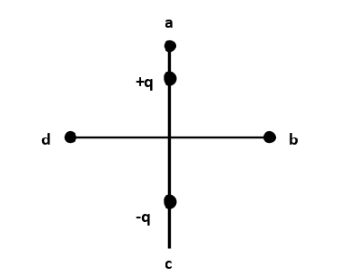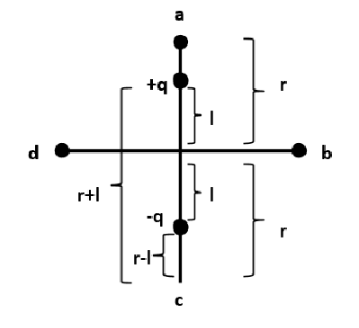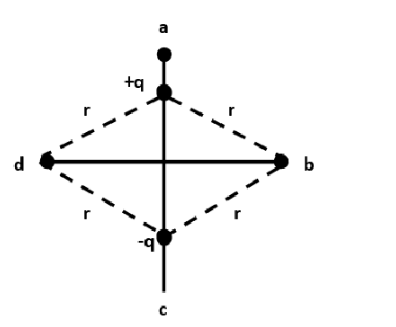
Four points \[a,b,c \] and \[d \] are set at equal distance from the center of a dipole as shown in the figure. The electrostatic potential \[{V_a},{V_b},{V_c} \] and \[{V_d} \] would satisfy the following relation:

A. \[{V_a} > {V_b} > {V_c} > {V_d} \]
B. \[{V_a} > {V_b} = {V_d} > {V_c} \]
C. \[{V_a} = {V_c} > {V_b} = {V_d} \]
D. \[{V_b} = {V_d} > {V_a} > {V_c} \]

Answer
532.2k+ views
Hint:It is given that four points \[a,b,c \] and \[d \] are set at equal distance from the center of a dipole. Then the expression for electrostatic potential of a charge placed at a point distant \[r \] from the origin is given by \[V = \dfrac{1}{{4\pi {\varepsilon _0}k}}\dfrac{q}{r} \] where, \[{\varepsilon _0} \] is the permittivity of vacuum, \[r \] is the distance of the charge and \[q \] is the charge (either positive or negative).
Electrostatic potential due to positive source charge is positive and negative source charge is negative.
Formula Used:
Electrostatic potential of a charge placed at a point distant \[r \] from the origin is given by
\[V = \dfrac{1}{{4\pi {\varepsilon _0}k}}\dfrac{q}{r} \]
Complete step by step solution:
\[a,b,c \] and \[d \] are the four points. Let the electrostatic potential generated by them be and \[{V_d} \] respectively. Let the distance of positive charge \[ + q \] and negative charge \[ - q \] be from the center of the dipole be \[l \] . Let the four points \[a,b,c \] and \[d \] be set at equal distance \[r \] from the center of a dipole.

So, the distance of charge point \[a \] from charge \[ + q \] is \[ = r - l \] , and that from charge \[ - q \] is \[ = r
+ l \] . The value of electrostatic potential \[{V_a} \] due to charge \[ + q \] will be
\[{V_a} = \dfrac{1}{{4\pi {\varepsilon _0}k}}\dfrac{{ + q}}{{(r - l)}} \] or \[{V_a} = \dfrac{q}{{4\pi {\varepsilon _0}k}}\dfrac{1}{{(r - l)}} \] \[ \to (1) \]
And that due to charge \[ - q \] will be
\[{V_a} = \dfrac{1}{{4\pi {\varepsilon _0}k}}\dfrac{{ - q}}{{(r + l)}} \] or \[{V_a} = \dfrac{q}{{4\pi {\varepsilon _0}k}}\dfrac{{ - 1}}{{(r + l)}} \] \[ \to (2) \]
The total potential at point \[a \] will be (Adding equations (1) and (2) )
$\Rightarrow {V_a} = \dfrac{q}{{4\pi {\varepsilon _0}k}}\left[ {\dfrac{1}{{(r - l)}} - \dfrac{1}{{(r + l)}}} \right] \\
\Rightarrow \dfrac{1}{{4\pi {\varepsilon _0}k}}\left[ {\dfrac{{(r + l) - (r - l)}}{{(r - l)(r + l)}}} \right] \\
\therefore {V_a} = \dfrac{1}{{4\pi {\varepsilon _0}k}}\left[ {\dfrac{{2l}}{{{r^2} - {l^2}}}} \right] \to (3)$
Similarly, the distance of charge point \[c \] from charge \[ + q \] is \[ = r + l \] , and that from charge \[ - q \] is \[ = r - l \] .

The value of electrostatic potential \[{V_c} \] due to charge \[ + q \] will be
\[{V_c} = \dfrac{1}{{4\pi {\varepsilon _0}k}}\dfrac{{ + q}}{{(r + l)}} \] or \[{V_c} = \dfrac{q}{{4\pi
{\varepsilon _0}k}}\dfrac{1}{{(r + l)}} \] \[ \to (4) \]
And that due to charge \[ - q \] will be
\[{V_c} = \dfrac{1}{{4\pi {\varepsilon _0}k}}\dfrac{{ - q}}{{(r - l)}} \] or \[{V_c} = \dfrac{q}{{4\pi
{\varepsilon _0}k}}\dfrac{{ - 1}}{{(r - l)}} \] \[ \to (5) \]
The total potential at point \[a \] will be (Adding equations (4) and (5) )
$\Rightarrow {V_c} = \dfrac{q}{{4\pi {\varepsilon _0}k}}\left[ {\dfrac{1}{{(r + l)}} - \dfrac{1}{{(r - l)}}} \right]$
$\Rightarrow \dfrac{1}{{4\pi {\varepsilon _0}k}}\left[ {\dfrac{{(r - l) - (r + l)}}{{(r + l)(r - l)}}} \right]$ $\therefore {V_c} = \dfrac{1}{{4\pi {\varepsilon _0}k}}\left[ {\dfrac{{ - 2l}}{{{r^2} - {l^2}}}} \right] \to (6) \\$
According to equation (3) and equation (6), the magnitude of electrostatic potential is the same for points \[a \] and \[c \] . Therefore, \[{V_a} = {V_c} \] .
Points \[b \] and \[d \] are equidistant from both the charges, positive as well as negative. Therefore, the electrostatic potential \[{V_b} \] and \[{V_d} \] will be zero. Thus, \[{V_b} = {V_d} \] . Since, \[{V_a} \] and \[{V_c} \] are greater than zero, therefore \[{V_a} = {V_c} > {V_b} = {V_d} \]
Hence, option (C) is the correct answer.
Note: The electrostatic potential at \[{V_b} \] and \[{V_d} \] is taken as zero since points \[b \] and \[d \] are equidistant from both the positive and negative charges. This can also be worked by applying the formula.

Let the distance of points \[b \] and \[d \] from the charges be \[r \] (Refer the diagram below). Then, the electrostatic potential \[{V_b} \] will be
\[{V_b} = \dfrac{1}{{4\pi {\varepsilon _0}k}}\dfrac{{ + q}}{r} \] or \[{V_b} = \dfrac{q}{{4\pi {\varepsilon
_0}k}}\dfrac{1}{r} \] \[ \to (7) \]
And that due to charge \[ - q \] will be
\[{V_b} = \dfrac{1}{{4\pi {\varepsilon _0}k}}\dfrac{{ - q}}{r} \] or \[{V_a} = \dfrac{q}{{4\pi {\varepsilon
_0}k}}\dfrac{{ - 1}}{r} \] \[ \to (8) \]
The total potential at point \[a \] will be (Adding equations (7) and (8) )
$\Rightarrow {V_b} = \dfrac{q}{{4\pi {\varepsilon _0}k}}\left[ {\dfrac{1}{r} - \dfrac{1}{r}} \right] \\$
$\Rightarrow \dfrac{1}{{4\pi {\varepsilon _0}k}}\left[ 0 \right] \\$
$\therefore {V_b} = 0 \\$
Similarly, \[{V_d} = 0 \]
Thus, electrostatic potential is zero at points \[b \] and \[d \] .
Electrostatic potential due to positive source charge is positive and negative source charge is negative.
Formula Used:
Electrostatic potential of a charge placed at a point distant \[r \] from the origin is given by
\[V = \dfrac{1}{{4\pi {\varepsilon _0}k}}\dfrac{q}{r} \]
Complete step by step solution:
\[a,b,c \] and \[d \] are the four points. Let the electrostatic potential generated by them be and \[{V_d} \] respectively. Let the distance of positive charge \[ + q \] and negative charge \[ - q \] be from the center of the dipole be \[l \] . Let the four points \[a,b,c \] and \[d \] be set at equal distance \[r \] from the center of a dipole.

So, the distance of charge point \[a \] from charge \[ + q \] is \[ = r - l \] , and that from charge \[ - q \] is \[ = r
+ l \] . The value of electrostatic potential \[{V_a} \] due to charge \[ + q \] will be
\[{V_a} = \dfrac{1}{{4\pi {\varepsilon _0}k}}\dfrac{{ + q}}{{(r - l)}} \] or \[{V_a} = \dfrac{q}{{4\pi {\varepsilon _0}k}}\dfrac{1}{{(r - l)}} \] \[ \to (1) \]
And that due to charge \[ - q \] will be
\[{V_a} = \dfrac{1}{{4\pi {\varepsilon _0}k}}\dfrac{{ - q}}{{(r + l)}} \] or \[{V_a} = \dfrac{q}{{4\pi {\varepsilon _0}k}}\dfrac{{ - 1}}{{(r + l)}} \] \[ \to (2) \]
The total potential at point \[a \] will be (Adding equations (1) and (2) )
$\Rightarrow {V_a} = \dfrac{q}{{4\pi {\varepsilon _0}k}}\left[ {\dfrac{1}{{(r - l)}} - \dfrac{1}{{(r + l)}}} \right] \\
\Rightarrow \dfrac{1}{{4\pi {\varepsilon _0}k}}\left[ {\dfrac{{(r + l) - (r - l)}}{{(r - l)(r + l)}}} \right] \\
\therefore {V_a} = \dfrac{1}{{4\pi {\varepsilon _0}k}}\left[ {\dfrac{{2l}}{{{r^2} - {l^2}}}} \right] \to (3)$
Similarly, the distance of charge point \[c \] from charge \[ + q \] is \[ = r + l \] , and that from charge \[ - q \] is \[ = r - l \] .

The value of electrostatic potential \[{V_c} \] due to charge \[ + q \] will be
\[{V_c} = \dfrac{1}{{4\pi {\varepsilon _0}k}}\dfrac{{ + q}}{{(r + l)}} \] or \[{V_c} = \dfrac{q}{{4\pi
{\varepsilon _0}k}}\dfrac{1}{{(r + l)}} \] \[ \to (4) \]
And that due to charge \[ - q \] will be
\[{V_c} = \dfrac{1}{{4\pi {\varepsilon _0}k}}\dfrac{{ - q}}{{(r - l)}} \] or \[{V_c} = \dfrac{q}{{4\pi
{\varepsilon _0}k}}\dfrac{{ - 1}}{{(r - l)}} \] \[ \to (5) \]
The total potential at point \[a \] will be (Adding equations (4) and (5) )
$\Rightarrow {V_c} = \dfrac{q}{{4\pi {\varepsilon _0}k}}\left[ {\dfrac{1}{{(r + l)}} - \dfrac{1}{{(r - l)}}} \right]$
$\Rightarrow \dfrac{1}{{4\pi {\varepsilon _0}k}}\left[ {\dfrac{{(r - l) - (r + l)}}{{(r + l)(r - l)}}} \right]$ $\therefore {V_c} = \dfrac{1}{{4\pi {\varepsilon _0}k}}\left[ {\dfrac{{ - 2l}}{{{r^2} - {l^2}}}} \right] \to (6) \\$
According to equation (3) and equation (6), the magnitude of electrostatic potential is the same for points \[a \] and \[c \] . Therefore, \[{V_a} = {V_c} \] .
Points \[b \] and \[d \] are equidistant from both the charges, positive as well as negative. Therefore, the electrostatic potential \[{V_b} \] and \[{V_d} \] will be zero. Thus, \[{V_b} = {V_d} \] . Since, \[{V_a} \] and \[{V_c} \] are greater than zero, therefore \[{V_a} = {V_c} > {V_b} = {V_d} \]
Hence, option (C) is the correct answer.
Note: The electrostatic potential at \[{V_b} \] and \[{V_d} \] is taken as zero since points \[b \] and \[d \] are equidistant from both the positive and negative charges. This can also be worked by applying the formula.

Let the distance of points \[b \] and \[d \] from the charges be \[r \] (Refer the diagram below). Then, the electrostatic potential \[{V_b} \] will be
\[{V_b} = \dfrac{1}{{4\pi {\varepsilon _0}k}}\dfrac{{ + q}}{r} \] or \[{V_b} = \dfrac{q}{{4\pi {\varepsilon
_0}k}}\dfrac{1}{r} \] \[ \to (7) \]
And that due to charge \[ - q \] will be
\[{V_b} = \dfrac{1}{{4\pi {\varepsilon _0}k}}\dfrac{{ - q}}{r} \] or \[{V_a} = \dfrac{q}{{4\pi {\varepsilon
_0}k}}\dfrac{{ - 1}}{r} \] \[ \to (8) \]
The total potential at point \[a \] will be (Adding equations (7) and (8) )
$\Rightarrow {V_b} = \dfrac{q}{{4\pi {\varepsilon _0}k}}\left[ {\dfrac{1}{r} - \dfrac{1}{r}} \right] \\$
$\Rightarrow \dfrac{1}{{4\pi {\varepsilon _0}k}}\left[ 0 \right] \\$
$\therefore {V_b} = 0 \\$
Similarly, \[{V_d} = 0 \]
Thus, electrostatic potential is zero at points \[b \] and \[d \] .
Recently Updated Pages
Master Class 11 Chemistry: Engaging Questions & Answers for Success

Why are manures considered better than fertilizers class 11 biology CBSE

Find the coordinates of the midpoint of the line segment class 11 maths CBSE

Distinguish between static friction limiting friction class 11 physics CBSE

The Chairman of the constituent Assembly was A Jawaharlal class 11 social science CBSE

The first National Commission on Labour NCL submitted class 11 social science CBSE

Trending doubts
What is meant by exothermic and endothermic reactions class 11 chemistry CBSE

10 examples of friction in our daily life

One Metric ton is equal to kg A 10000 B 1000 C 100 class 11 physics CBSE

Difference Between Prokaryotic Cells and Eukaryotic Cells

What are Quantum numbers Explain the quantum number class 11 chemistry CBSE

1 Quintal is equal to a 110 kg b 10 kg c 100kg d 1000 class 11 physics CBSE




